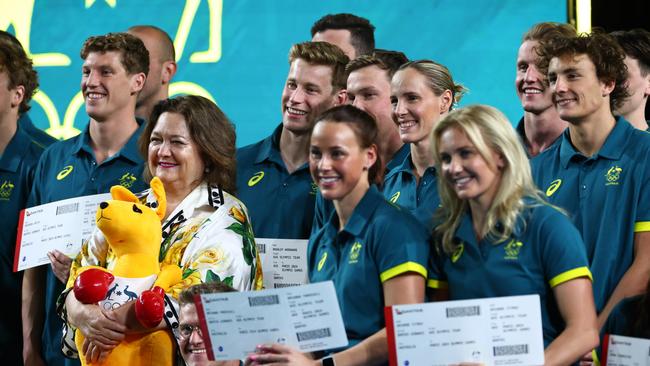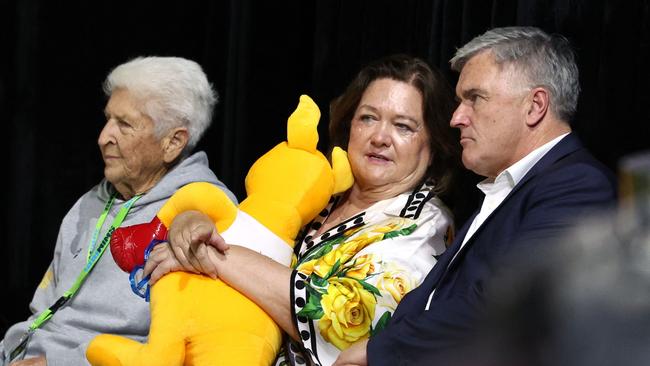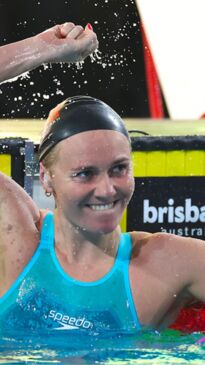2024 Paris Olympic Games: How Gina Rinehart helped save swimming as Olympic funding issue heats up
The government announced a $500m Olympic sport funding package this week, including more funding directly to athletes. But many Olympians still credit Australia’s richest person as a vital source of support for cash-strapped competitors.

To get an indication of how much billionaire Gina Rinehart loves financially backing Olympic athletes, consider the celebration she plans to hold in Paris midway through the upcoming 2024 Games.
Several sources say Rinehart, Australia’s richest person, will host a glittering luxury boat tour down the River Seine early in the second week of the Olympics as a celebration for the swimming and rowing medal winners and competitors, plus assorted dignitaries.
Through her foundation and her Hancock Prospecting mining giant, Rinehart pours an estimated $10 million annually into athlete support for swimming, rowing, volleyball and artistic swimming athletes.
Olympic great Cate Campbell says Rinehart has saved Australian swimming, so important is those direct payments to otherwise cash-strapped young athletes who had struggled to balance an intense training regimen with work or study.
Now, they are effectively paid a decent wage to train to become Olympic champions.
Campbell says Rinehart has revived the sport from a nightmarish 2012 Olympic campaign, where Australia only won one gold medal, to what she describes as the “golden age” of swimming.
“Gina came on board in 2012, which was a difficult time for swimming, and without being melodramatic, I believe that she has saved the sport,” Campbell tells The Weekend Australian.

“I think that swimming would not be in the strong position that it is today without the support of Hancock and Gina Rinehart. It’s just the fact and irrespective of what people’s opinions are politically on certain people or certain industries, we are in a golden age of swimming.”
Hancock sources are at pains to point out her generosity should not in any way be compared with the hundreds of millions the federal government pours into Olympic sports annually.
Government officials, meanwhile, are a little bit miffed the billionaire often gets called out publicly by grateful athletes publicly at Olympic trials and lead up events.
Each side means well, but the vexed subject of Olympic sport funding has raised its head again this week when Prime Minister Anthony Albanese on Friday unveiled a $500m funding package – including about $205m in previously announced funding for the Australian Institute of Sport – for Olympic sports for the next two years.
The package was announced the day before Mr Albanese and Sports Minister Anika Wells are appearing at the Prime Minister’s Olympic Fundraiser dinner on Saturday night in Melbourne, one of the big-ticket items in the Australian Olympic Committee’s efforts to raise money to send the team to Paris in about three weeks.

Sport officials, already operating on shoestring budgets, were quick to look for the devil in the detail of Friday’s revelations – “how much is new money,” was the general cry from leaders worried about Australia’s performance slipping as Brisbane 2032 nears.
The answer to that “what is new” question is, sports officials were told on Friday, is about $74.5 in high-performance per year, with the federal government claiming its new two-year $283m package is worth 50 per cent more than what was doled out over 2021/22. Though even that new funding figure was being questioned by some sports initially on Friday, with early reactions calling for more information.
“We welcome the funding but look forward to seeing the detail together with the distribution model given indoor volleyball currently receives zero from the Australian Sports Commission or AIS and is already deep into preparation for Brisbane,” Volleyball Australia president Craig Carracher said on Friday.
Carracher also said federal funding for hosting the Beach Volleyball World Championships in Adelaide next year was still not forthcoming, despite previous promises, but was hopeful a mention of event funding in the Prime Minister’s funding announcement could lead to money being available.
Carracher and others sports leaders are at least initially pleased with an increase of $17.6m to the Direct Athlete Investment Support Grants (dAIS) program over the two years, adding to the $14.03m being paid directly to athletes each year by the government under previous arrangements.
Meanwhile, the cost for the AOC to send athletes to Paris is also increasing. The AOC is spending $25m alone on the Games, including extra funds to put athletes and officials up at hotels when they are not in the Olympic Village.
The AOC hit its target of raising about $75m in sponsorship over four years, and the Australian Olympic Foundation now boasts $188m in assets spread across Australian and international shares, direct property and unlisted infrastructure, fixed interest and cash.
Its stellar investment performance means it has distributed $150m in 24 years to the AOC, including $34.4m in the past four years, compared with $25m in the previous period.
The foundation is built off the AOC’s $88.5m windfall from the 2000 Sydney Olympics and while it has meant the AOC doesn’t need direct government funding, it also does not share the foundation’s funds or benefits directly with cash-strapped sports.
“We appreciate the sports look at the dollars there but that allows us to say anyone who qualifies for the Games goes,” says AOC chief executive Matt Carroll.
Yet the sports themselves are in a constant state of financial struggle, as several examples of their balance sheets show.

Table Tennis Australia, boasting top performers such as Paralympic medallist Melissa Tapper, had net assets of $723,000 in 2023 and of its $3m revenue about $1.7m was from government grants and $100,000 from sponsorship.
Equestrian Australia entered voluntary administration in mid-2020 and has been working its way back to relative financial health. It made a $12,113 profit from $9m revenue last year.
Volleyball Australia, which counts Hancock as a major partner, had record revenue of $11m in 2023 but the cost of staging the Great Ocean Road Volleyfest event meant it recorded a financial deficit.
One sports board member told The Weekend Australian that modern data tracking has also done sports few favours when it comes to attracting corporate support.
“I can remember the days when you’d get sponsorship from a company like (former airline) Ansett or a company like that because they’d want to help out and it was seen as something good for the community,” the official said.
“These days sponsors mostly are looking for a return on their investment and a lot of that is measured on reach and how many eyeballs their brand gets in front of.
“That makes it harder for an Olympic sport, which can’t service their sponsors at their biggest time – the actual Olympics because rights are held by the AOC – and it is easier for a brand to just sponsor a footy club that plays every week on TV half the year.”
Given the precarious nature of the sports financially and the tough financial situation for many aspiring athletes, it is little surprise a supporter like Rinehart has been so welcomed.
The billionaire spent $60m assisting athletes from after the London 2012 Games through to Tokyo in 2021 and is now likely closing in on the $100m mark – which will be easily beaten given she has promised to keep up the support until Los Angeles 2028 and then Brisbane four years later.
Hancock’s money is funnelled directly to swimmers via Swimming Queensland, and rowers also get paid about $600 per week directly as well as the sport receiving some funding for rowing training camps and other high-performance matters.
Rinehart has also been a keen supporter of volleyball, including joining with Carracher to pay for facilities at the Commonwealth Games in 2018.
In the case of artistic swimming, Hancock money allowed the athletes to centralise their training hub in Perth – and performances have since risen.
Meanwhile, Rinehart’s 2GR Premium Wagyu Beef brand also supplies athletes based in Western Australia, and some on the other side of the country, as does her Bannister Downs dairy business. Some artistic swimmers are now employed by Hancock.
Campbell says swimming’s golden age is directly related to the Hancock funding of the last decade.
The freestyler this week retired after just falling just heartbreakingly short of making her fifth Olympics. Campbell, 32, revealed to The Weekend Australian that she and other retiring athletes can continue to receive funding even though she has stopped competing, a move that the decorated swimmer labelled “incredible”.
“While I didn’t quite get there to a fifth Olympics, (the funding) extended my time in the sport – but there’s now also a transition period for retiring athletes, whereas in the past, it was as soon as you retired, funding was cut off immediately,” Campbell says.
“And that compounds the stress and mental toll of retiring or losing your identity and then suddenly losing your income and your livelihood. So they’ve now extended that funding and that’s incredible.”



To join the conversation, please log in. Don't have an account? Register
Join the conversation, you are commenting as Logout